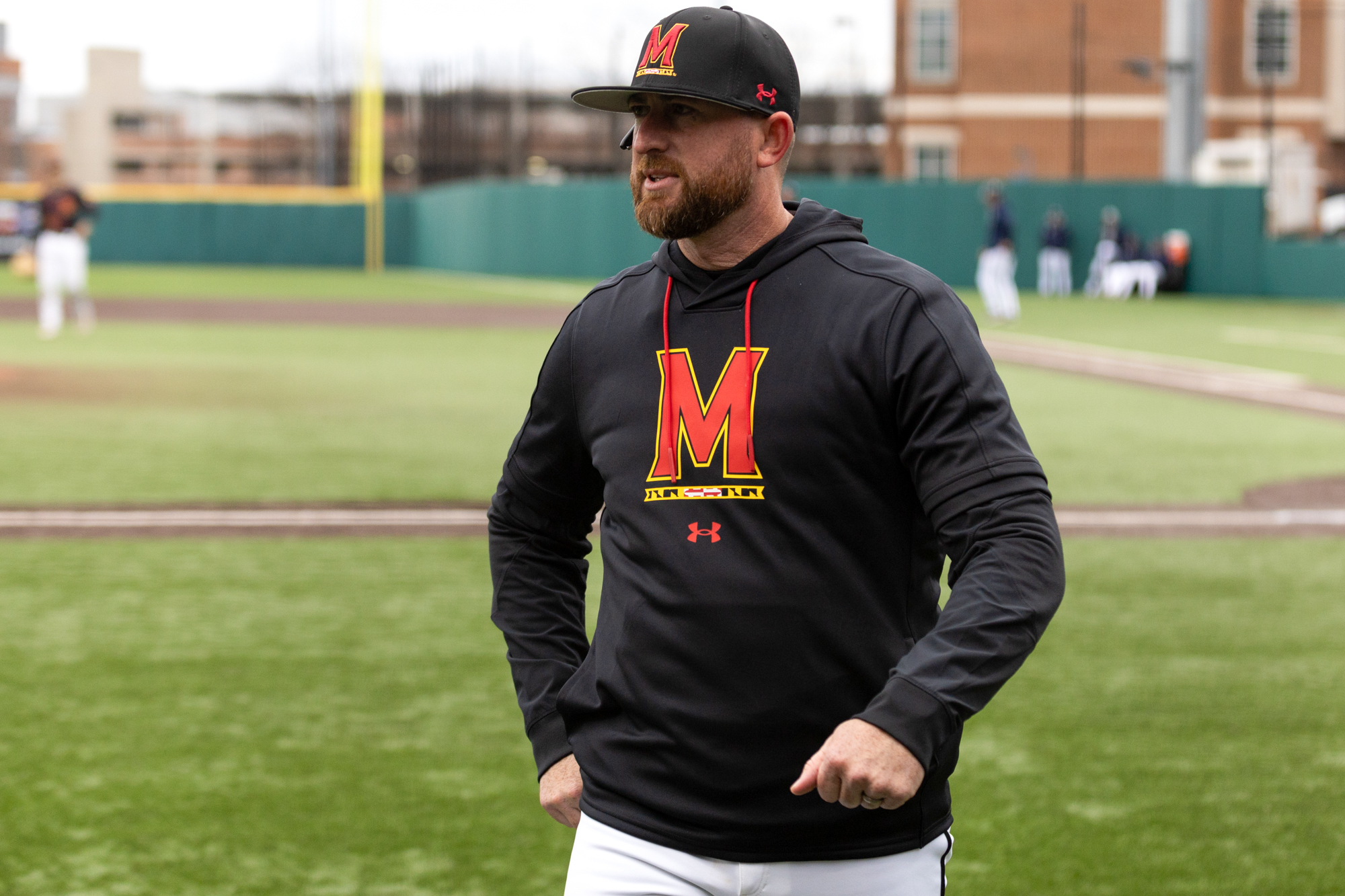A poor offensive showing at the Cambria College Classic made coach Rob Vaughn want to watch his team’s highlights from last season. Maryland slugged 137 home runs in 2022 and Vaughn rewatched nearly all of them.
As the coach saw ball after ball get peppered over the outfield fence, he noticed who was hitting a lot of them and who was on base.
Nick Lorusso hit in front of Matt Shaw last season, third and fourth in the lineup, respectively. Lorusso and his .409 on-base percentage reached safely for many of Shaw’s 22 homers. Vaughn initially had Shaw ahead of Lorusso to begin 2023. After reviewing what made his team so successful a season ago, the coach switched them back.
Maryland is averaging 12.8 runs per game since the change. It’s one example of how Vaughn, after 16 games and on the verge of Big Ten play, is beginning to identify his players’ strengths and the roles that fit best for them. The season didn’t start how the coach hoped, but the challenging opening slate allowed Vaughn to realize his mistakes and adjust.
“I didn’t feel like I had guys maybe in the right spots, whether it was at the plate or whether it was coming out of the bullpen,” Vaughn said. “You’d much rather learn that late February, early March and make that adjustment and get rolling as the season heats up.”
[Kyle McCoy, Nate Haberthier allow Maryland baseball to coast to 9-1 win over Maine]
Maryland had games scoring just one and three runs, its two lowest outputs of the season, during the weekend before Vaughn reconfigured his lineup — including moving Kevin Keister to fifth.
Lorusso is enjoying one of the best stretches of his Terps tenure since the switch. The third baseman is 9-for-22 at the plate in his last five games with four homers and 10 RBI. Moving up in the order coincides with improved confidence for Lorusso, who said he’s been more patient as he hunts pitches in the middle of the zone he can barrel.
Keister has a hit in every game since moving to fifth and has driven in eight runs now that he follows Lorusso and Shaw in the order.
“[Lorusso] and Shaw, they’re always on base,” Keister said. “It’s always nice having people on base [to] bring up your RBI count.”
Changes were also needed in Maryland’s bullpen, a unit whose highs and lows defined the Terps’ 4-7 start. Relievers were used in various roles as Vaughn searched for the right one for each pitcher. In the 5-4 win over Maine in Game 2 of the series, the bullpen’s top arms flashed their potential when used correctly.
Kenny Lippman threw a scoreless frame after being the first arm to follow starter Nick Dean. Lippman gave way to left-hander Tommy Kane, who worked 1.2 scoreless frames facing mostly lefties. When he loaded the bases in the eighth, it was Nigel Belgrave’s turn.
The flamethrowing right-hander collected four strikeouts, one to end the eighth inning and three more to strand the bases loaded in the ninth, to seal the victory.
Lippman, Kane, Belgrave and David Falco Jr. are the four relievers Vaughn will aim to deploy most in late innings moving forward, a foursome the coach now feels confident in as they fit into more defined roles.
“As coaches, we’re still trying to figure out the right buttons to push, the right combination of guys,” Vaughn said after the win. “When you can use them in a situation like that, that’s what they’re capable of.”
The final game of the Maine series was Maryland’s first chance to obtain a three-game sweep. Nate Haberthier, with a 8.76 ERA through three starts, started Sunday games up until then.
[Improved pitching, Ian Petrutz’s homer lifts Maryland baseball past Maine, 5-4]
Like other areas, Vaughn knew a shakeup to the end of his rotation was necessary to yield better results. He turned to Kyle McCoy, a freshman left-hander, to serve as an opener for Haberthier. It allowed him to warm up as he usually does but not enter until the middle innings and exude more effort knowing he’d be throwing fewer pitches.
The two combined to allow one run over seven innings with 11 strikeouts in a 9-1 win. Despite it being one of his shortest outings, Haberthier produced a season-high eight punchouts.
“Our styles are totally opposite,” Haberthier said. “I’m a two-seam guy with a slider, [McCoy is] a four-seam guy, so it was a different look.”
The contrast in the pitchers’ styles is why they pair well, Vaughn and Haberthier agreed. McCoy’s three-quarters arm slot makes it difficult to track the ball to the plate. Then Haberthier enters with more velocity from the right side. Without the chance to see either of them consecutively, it prevents hitters from finding a rhythm until late in the game.
Vaughn plans to use that approach more. Whether Haberthier starts and McCoy enters in the middle innings or the freshman begins the game and Haberthier comes on after, the two will be used together in future Sunday games.
“We’ve talked about us trying to get guys in the right spots,” Vaughn said. “If those two guys can pair up on Sunday in some way, shape or form, we have a chance to be really good.”
Maryland’s won five consecutive games thanks in part to the changes Vaughn made. He drew on past experiences, such as recognizing what powered the top of his lineup and understanding deeper pitching is required to win in June.
The Terps aren’t there yet, but Vaughn believes his team is inching closer to mimicking the dominance last year’s group displayed.
“The thing I like about this team is we’re not even close to playing our best brand of baseball yet,” Vaughn said.



